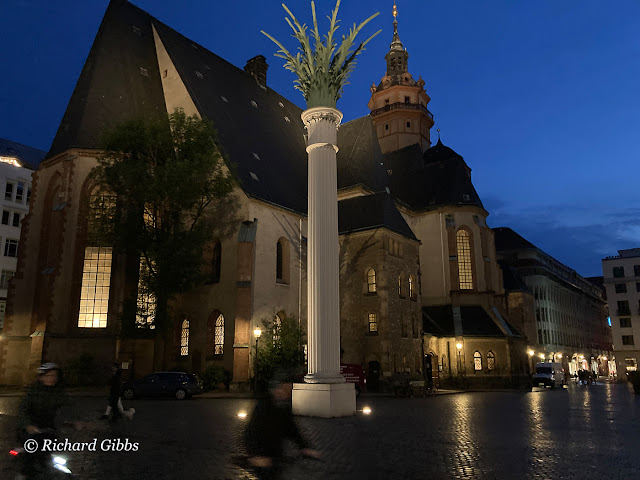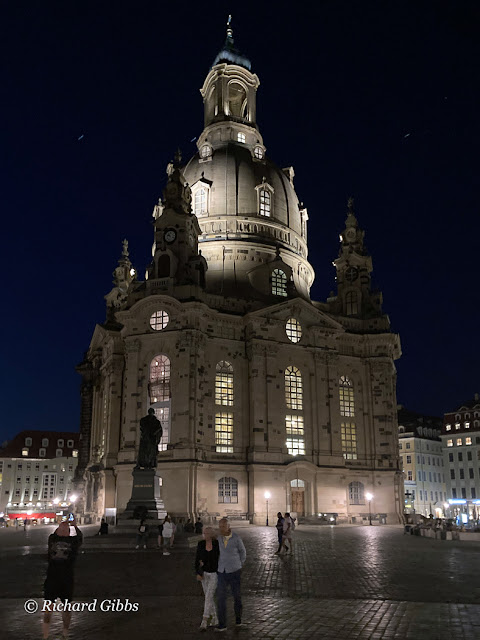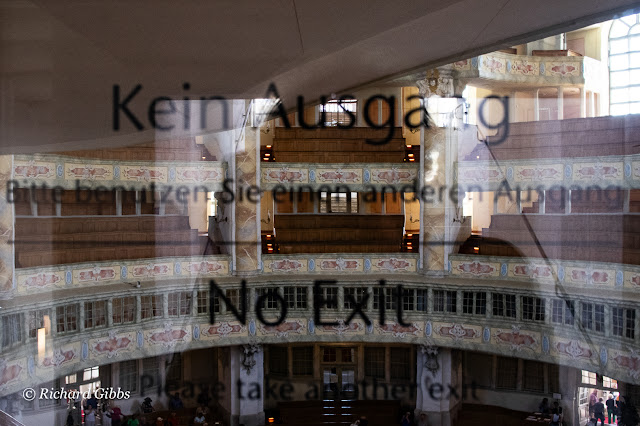And so to Leipzig..... (Bach to the Beginnings)

On May 30th, 1723, Johann Sebastian Bach, aged 38, took up his post as Thomaskantor at the morning service in St Nicholas’ Church. He and his family had been in Leipzig for a week. He conducted musicians and choir in a new Cantata, Die Elenden sollen essen, (The Poor shall eat), BWV 75.

Over the next four years he composed around 150 new cantatas as well as The St John Passion and The St Matthew Passion. He was extraordinarily productive, whether you like it (his work) or not.
 |
| Petra Flemming - Basketmaker, 1979 |
I claim profound ignorance of almost everything, but, having visited Bach’s birthplace and other towns associated with him in 2015 (please see https://www.richardpgibbs.org/2015/06/j-s-bach-funky-genius.html for more of this) I felt the need to follow him to the grave (which is kind of inevitable in itself.....)
My ignorance is well-tempered, however, as I have been practising the Eighth Prelude from the 48 Ps & Fs since The Beatles came out with A Hard Day’s Night (and I still can’t play it (Bach) properly). But it does mean I have some idea of how many sharps and flats JSB could get on a page.
And Leipzig was his apogee, perhaps. Gone were the days when he drunkenly fought a Zippel Fagottist(bassoonist) who hit him with a stick (Arnstadt, 1705) or when he would trek to Lübeck to see Dietrich Buxtehude play the organ (or was it to woo the master’s tochter?) No this was a serious and mature musician with his second wife, various children and four wagonloads of household goods.....
 |
| Petra Flemming - Basketmaker's Wife, 1979 |
He got the job in Leipzig because Telemann turned it down – not everyone can say that. His responsibilities included the musical education of the boys in the Thomasschule; music in all four principal churches of Leipzig, under their clergy; and the musical aspects of the municipal celebrations, under the town council. His contract stipulated that his behaviour should preserve the good order in the churches and that the music should not last too long.
Cantata 75 lasts about 35 minutes, in two parts, so almost broke his contract, but it was met, according to the press, mit guten applausus.
Cantata 75 was the third piece performed at the Opening Concert of the tercentenary celebration of Bach’s arrival in Leipzig, and I was privileged to have a seat in the ThomasKirche to hear it. It was exciting, and uplifting, despite the simple fact that I didn’t really understand a word (I am a little rusty on the Gospel text, Luke 16: vv19-31, about poor Lazarus and the rich man, though I recall the Fairfield Four singing about him at the Ryman Auditorium).
The church has changed a great deal in the years since Bach strutted his stuff here, but there is a certain sense of continuum. I sit next to a couple from the city of Bielefeld, a city of 334,000 residents, dating back to the 9thcentury, which owes its fame to a joke made in 1994 when a student posted a message denying its existence, a joke that Mrs Merkel picked up in 2012. The ribaldry went so far that in 2019 the city offered €1m to anyone who could prove that it didn’t exist..... Of course there was no proof that my new friends were really from Bielefeld.....
Sorry..... Where was I?

The following night I attended a second concert, this time in the Nikolaikirche, another of Bach’s main churches, but again much changed since the early eighteenth century. This concert, under the direction of Hans-Christoph Rademann, was a more user-friendly evening that the Opening Show. There was simultaneous translation of the explanatory notes and the music was all Bach. I heard voices encouraging me not to fear death – death is not negative (Mein Tod ist nur ein Schlaf....) I heard the pizzicato passing of time; the wavering of the orchestra at the beginning of BWV 48 which suggests waves of water, and uncertainty; and the oboe in BWV 60 mimicking a hen and chickens as Bach reminds us of the protective power of nature.....

It was a marvellous concert, though I recently read something that Eugen d’Albert (a member of the Bach Geselschaft) wrote in 1906: There are those who can sit and listen to Bach’s cantatas for two hours at a stretch and say they enjoy it and do not grow tired of it. They are either incorrigible pedants or unmitigated dissemblers.....

Perhaps I am nothing but a shallow fraud. Bernard Levin said (in 1975) I know that Bach was one of the greatest geniuses ever to adorn the human race, and that he wrote some of the most sublime music in all history. But he leaves me, literally cold....

But Nina Simone said, Bach made me dedicate my life to music....
 |
| Ulrich Hachulla - First Day of Retirement, 1976/77 |
I don’t know. It’s all a bit beyond me, perhaps. I came to Leipzig to hear Bach where his music was first performed, and I have done that. Tick. But I really should have gone Bach to the Beginning and heard just one cantata as part of a Sunday service. That, perhaps, would have been genug.....

Anyway, the serious stuff over, a Litre of Pils in the Augustiner am Markt revives the parts that were wilting a little in the heat, and then there’s Lang Lang (郎朗) playing Bach’s Greatest Hits behind a high hoarding in the Market Square.... Such open-air recitals are normally free to the good citizens of Leipzig (and beyond) but Lily LangLang charged the city so much that they had to pass on the expense. What would Johann have thought of that? (And he don’t even play the Klavier).

Anyway, since I was here, like a proper tourist, there are sights to see. First up, the Bach Museum. OK. Yeah. A bench and some kind of organ manual (manual organ?) Some things that go ding. A few pics of yesteryear and a window that give a view of a statue. My advice, if you can take it, is go to Eisenach if you want the real thing....

Next, the Bayerischer Bahnhof, first opened in 1842 and closed in 2001. It is Germany’s oldest preserved railway station, but now only rises above the S-Bahn Mitteldeutschland system. However, you can forget that, for today the Bayerischer Bahnhof is famous for its hospitality and culinary delights – and it is known as the home of Gose, a beer specialty from Leipzig which was brought to Saxony-Anhalt in the year 1738. {Originally Gose comes from Goslar, a small town in Lower Saxony... and so on (oooh, that makes me thirsty!)}
 |
| Joachim Kratsch - In Memory Of, 1973 |
And then, the ugliest construction that side of Slough, the Völkerschlachtdenkmal (Monument to the Battle of the Nations), a 300,000 ton, 91 metre high, granite monstrosity dreamed up by poet Ernst Moritz Arndt in 1814 to honour the fallen in the one decisive victory over Napoleon on German soil. 600,000 soldiers from 20 countries took part and 100,000 were killed or wounded. For good measure, typhus broke out in Leipzig after the skirmish, and a further 10% of the local population succumbed. 100 years after the event, the monument was completed. Over 100 years after that, it is still there.....

I am offered a separate diversion by the Leipzig Tourist People - a boat trip on the extensive canal system. Why not? And so, for almost an hour and a half I could have been in Birmingham - factories turned into apartments, crumbling houses in overgrown gardens, thick green waters swirling past - except for the extraordinary abundance of all sorts in canoes and similar craft, paddling gently towards oblivion with the distinctive aroma of wacky baccy floating in the air.....

What else? I sense you may be tiring of Leipzig and its charms? But one more delight is to be found in the MdbK. Say that again? The Museum der Bildenden Künste, which is, to put it mildly, a rocking fine museyroom, sensitively organised over several floors, with art and artists arranged by theme or school, from Lucas Cranach the Elder through Caspar Friederich to Max Beckmann and artists of the Leipzig School.
 |
| Norbert Wagenbrett - Girl on the Street, 1987 |
Which takes us, almost inevitably, to the Gedenkstätte Museum in der Runden Ecke (the Round Corner), primarily an exhibition about the Stasi, the former secret police in East Germany, (one time employer of Vladimir Putin) as Leipzig’s history is inextricably confused by the GDR period during which everyone spied on everyone else. For forty years, the Socialist Unity Party of Germany infiltrated society with suspicion and physical and mental violence. Until 1989 this building housed the Leipzig District Administration for State Security. This secret service apparatus penetrated into the most private aspects of people’s lives, sowed mistrust among neighbours, and violated the most elementary human rights. Almost every aspect of freedom was suppressed, from friendship to art, music to thought.

Definitely worth a visit (though, of course, for purely historical reasons - these things couldn't happen today....).

To reflect on this, I drink more Gose beer in Gosenschenke Ohne Bedenken, (which could translate as Unscrupulous Beer Hall, but which might more generously be Beerhall Without Hesitation....) a fair walk north of the centre. Here the skinhead barman anticipates retirement (in two years) when he will decamp to Chang Mai (Thailand) where (with no sense of irony) he intends to shed the problems of immigration which he sees as having ruined Germany (he quotes knife crime as one of the biggest problems). His beer is good. Not sure about his vision.
 |
| Otto Thielicke - Refugees, 1948 |
And to finish, some Allasch (a caraway liqueur, peculiar to Leipzig) in the First Whiskey Bar, where celebration goes on late into the night with other Bach enthusiasts due to the resignation of one Alexander de Pfeffel Johnson....

As I wander off into the night, I think of Bach again. All this modern stuff. If, I muse, Johann Sebastian Bach were alive today.....
.....He would be turning in his grave.
Boom, Boom!
 |
Leipziger Straßenmagazin KiPPE
(The Leipzig Big Issue) |
The poor shall eat.....
 |
Gerhart Kurt Muller - Foreman, 1971/72
|


















































